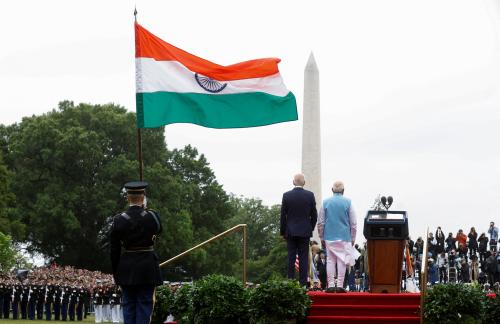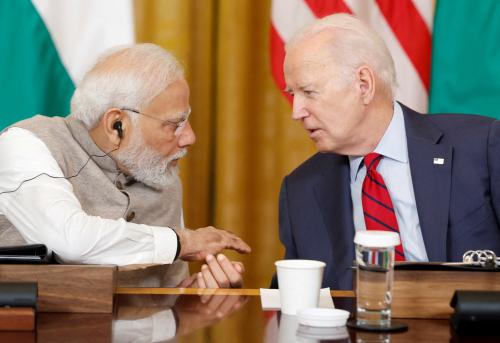In addition to riveting the attention of the world, the most dramatic American presidential election in many decades contains good news for U.S.-Indian relations.
For one thing, India is rarely mentioned on the campaign trail. That’s good, for when a foreign country is singled out on the American hustings, it is often for censure, complaint, or a promise that the candidate, if elected, will be tougher in handling the relationship in question. In the current political season, China, Iran, and Russia are all getting bashed for one reason or another. India had a taste of this treatment in the 2004 presidential election. At issue then was the off-shoring of service jobs, allegedly at the expense of American workers. So far, there has been much less of that this year, despite the rising mood of protectionism in both political parties.
More important than the campaign itself—which, as always, is rarely conducive to sound policy debate—is the likely nature and direction of the next presidency. On that score, too, there is good news, both for India and for the world as a whole.
While there are significant differences between John McCain and Barack Obama, either one is likely to pursue foreign policies that will, in several respects, be welcome abroad. The two candidates are distinguishing themselves not just from each other but also from the president they want to succeed. They are doing so promising to rely more than George W. Bush on diplomacy and international institutions and to take a more cautious approach toward unilateral American military force.
One issue of intense and legitimate concern to Indians is the next administration’s policy toward Iran. On that score, McCain is more hawkish than Obama. But neither candidate is, if elevated to the White House, likely to take precipitous action without exhausting coordinated diplomacy and consulting closely with countries whose interests are affected, notably including India.
Another subject certain to figure in an intensified official dialogue between Washington and New Delhi is the ominous way in which Pakistan’s border areas have become, de facto, an extension of Talibanistan and Al-Qaedistan.
An additional reason for Indians to take heart from the political contest underway in America is that the positive phase in U.S.-Indian relations that began a decade ago is, quite simply, not being debated. Virtually no policymaker, politician, or, for that matter, member of the foreign-policy élite or mainstream media questions the wisdom of what President Clinton began with the BJP-NDA and what President Bush has continued with the INC-UPA.
There is, of course, the perennial question of U.S.-Indian civil nuclear cooperation. As of now (July 3), while there still seems to be some hope in New Delhi for a last-minute rescue of the deal that Bush worked out with Prime Minister Manmohan Singh, U.S. government officials remain skeptical. They fear the pact is a fatally wounded victim of Indian internal politics—subject, perhaps, to resurrection next year, when there will be a new leader on the U.S. side and might be one on the Indian side as well. In that case, McCain or Obama would inherit a tricky and consequential piece of unfinished business. Both supported the Bush-Singh deal. However, it is unclear whether either, as president, would simply endorse and implement it in its present form. The winner of the election might, in some fashion, link full implementation of the deal to Indian acceptance of the Comprehensive Test Ban Treaty, which the Bush administration has staunchly opposed. Obama has been forward-leaning with regard to U.S. ratification of the CTBT, and McCain, who voted against the treaty’s ratification in 1998, has said he might reconsider his position, since he has an overall posture that is much more favorable toward the Nuclear Nonproliferation Treaty (NPT) than Bush’s.
Given India’s longstanding neuralgia with regard to the CTBT (exceeded only by its even deeper antipathy to the NPT, a U.S. president who moved back toward the CTBT would have a delicate and difficult time with his Indian counterpart on the terms of bilateral nuclear cooperation.
Thus—whatever the status of the U.S.-Indian civil nuclear deal early next year—both nations’ leaders still have their work cut out for them in cooperating to stop, and then reverse, the unraveling of the international nuclear nonproliferation regime. That is a goal that Indian leaders have espoused as a general proposition but have yet to find a way of advancing in practice.
America’s and India’s leader will also have to contend with the danger of a tipping point in global warming – a crisis for the planet that, if not averted, could have catastrophic and irreversible consequences for many species, including our own. On this issue too, McCain and Obama have committed themselves to a course very different from Bush’s: he kept the U.S. on the sidelines of the Kyoto Protocol, while his would-be successors seem determined that the U.S. will play a leading role in negotiating a successor climate-control regime ,one that, unlike Kyoto, includes major countries of the developing world.
So while the leaders who reside at 1600 Pennsylvania Avenue and 7 Race Course Road next year will inherit a U.S.-Indian relationship that is on an upward trajectory, they will stand a better chance of meeting the momentous challenges they face if they are can translate into concerted action all the talk in recent years about the world’s oldest and largest democracies being “natural allies” and “strategic partners.”
Strobe Talbott is president of the Brookings Institution in Washington, D.C., and the author of The Great Experiment: Ancient Empires, Modern States, and the Search for a Global Nation. He served as deputy secretary of state in the Clinton administration and was the president’s special envoy for the U.S.-Indian dialogue of 1998-2000.



Commentary
Op-edWhy All Augurs Well for India-U.S. Relations
July 3, 2008